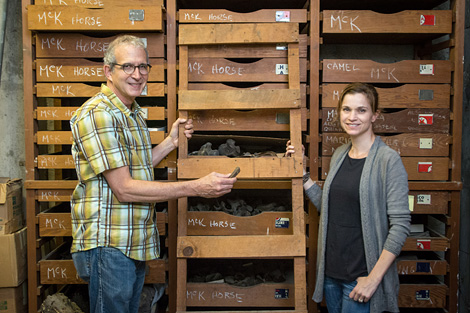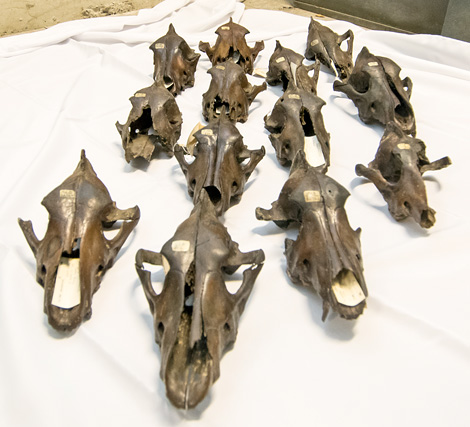
If you have taken the elevator to the top of Sather Tower, aka the Campanile, perhaps you’ve heard that some of the floors of the tower are filled with fossils. This is not a campus myth, it’s fact!
The Campanile is celebrating its 100th anniversary this year and its very first occupants — moving in before the tower was even completed — were fossils. At that time, the museum and Department of Paleontology were in Bacon Hall, just east of the Campanile, so as a storage facility, the tower was conveniently located. Although the museum has moved several times over the past century, the fossils in the Campanile have not.
Some of the first fossils to be moved into the tower were vertebrate bones from John C. Merriam‘s excavations at the Rancho La Brea tar pits. These bones, collected prior to 1914, occupy four of the five floors devoted to fossil storage. But the Campanile houses several other collections too. There are bones collected in the 1930s from asphalt deposits in McKittrick (about halfway between San Luis Obispo and Bakersfield) and nearby Maricopa; mammoth bones, teeth, tusks, and other miscellaneous Pleistocene fossils; modern whale bones; a few blocks containing ribs of the plesiosaur Hydrotherosaurus alexandrae; crates containing plaster casts of dinosaur footprints and trackways that were made by Sam Welles while doing field work in the Kayenta Formation of Arizona; petrified wood from the Petrified Forest; fossil plants; invertebrate fossils, including collections moved to the Campanile from McCone Hall and some from Triassic rocks in Nevada; Upper Cretaceous leaves from Bryce Canyon, Utah; oil company collections of microfossils (bulk samples) and invertebrates; casts of mastodont skulls; an ichthyosaur skull; some sculptural reconstructions (including a glyptodont); and cases of reprints. A conservative estimate of the number of fossils stored in the Campanile, excluding the microfossils, is 300,000.

During this year-long celebration of the Campanile, it is only fitting that the fossils housed there receive some attention too. We will periodically post blogs throughout the year to discuss some of the ongoing research projects that involve the Campanile’s fossils. For instance, UCMP Curator and Associate Professor of Integrative Biology Leslea Hlusko and her lab have two projects underway and Eric Holt, an undergrad in Tony Barnosky‘s lab, is looking at wolf morphometrics. And back in September we announced the grant award from the Institute of Museum and Library Services to curate the Campanile’s McKittrick fossils. To date, more than 2,500 specimens have been cleaned and cataloged, and more than 500 images of 273 specimens have been added to CalPhotos.

Stay tuned for more about the Campanile’s fossil treasures!